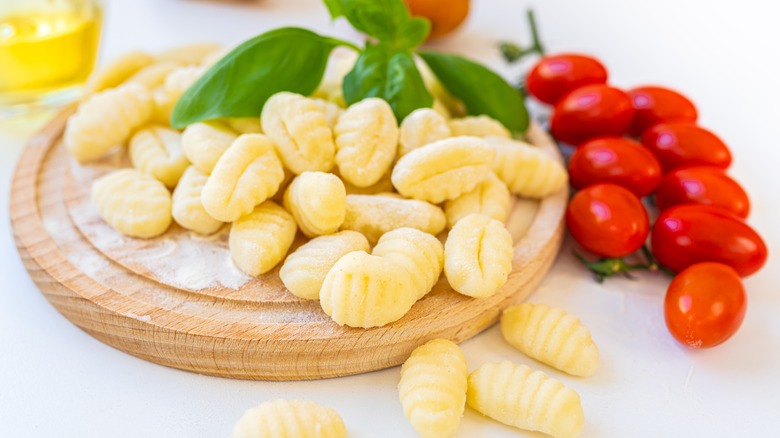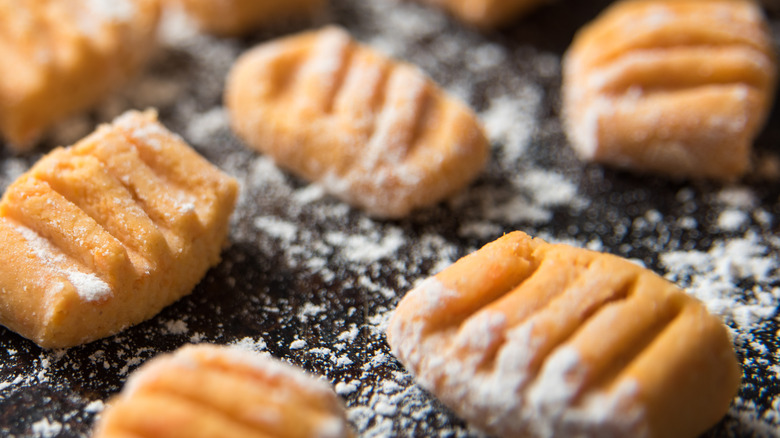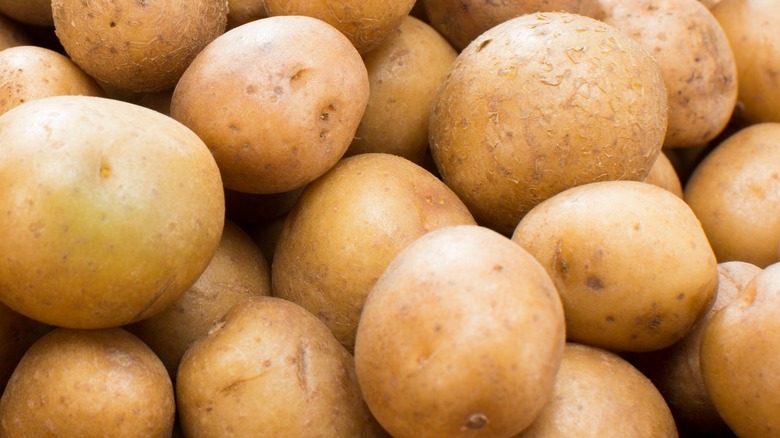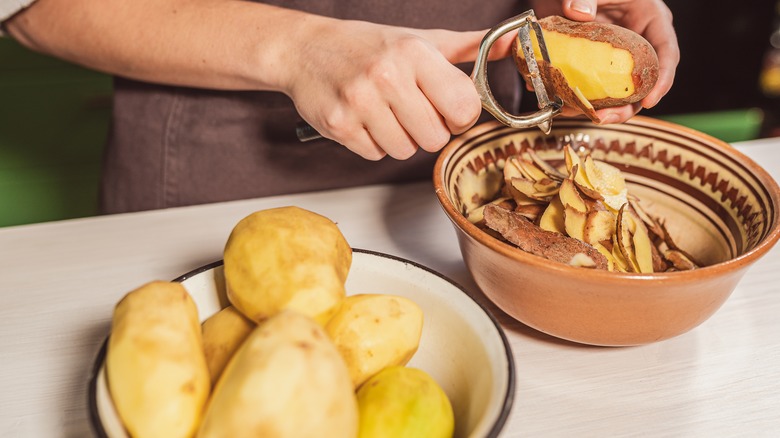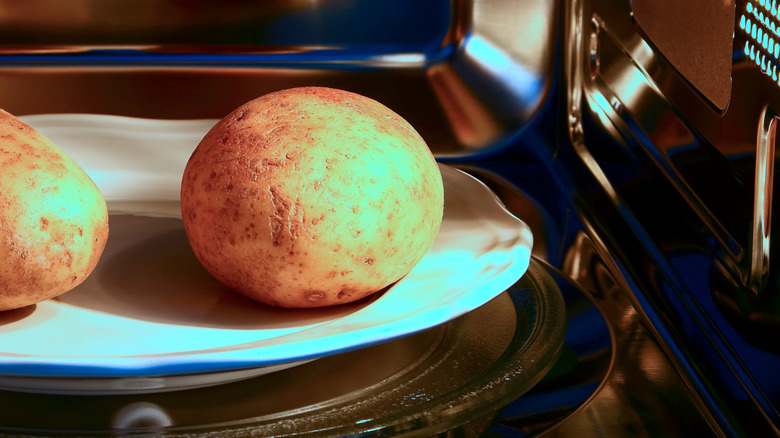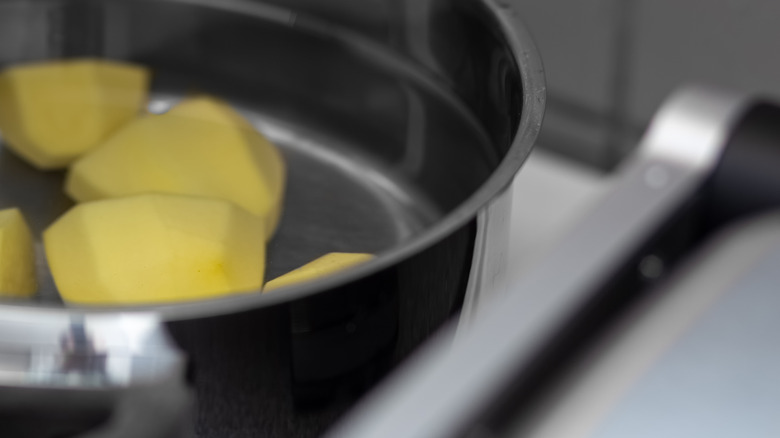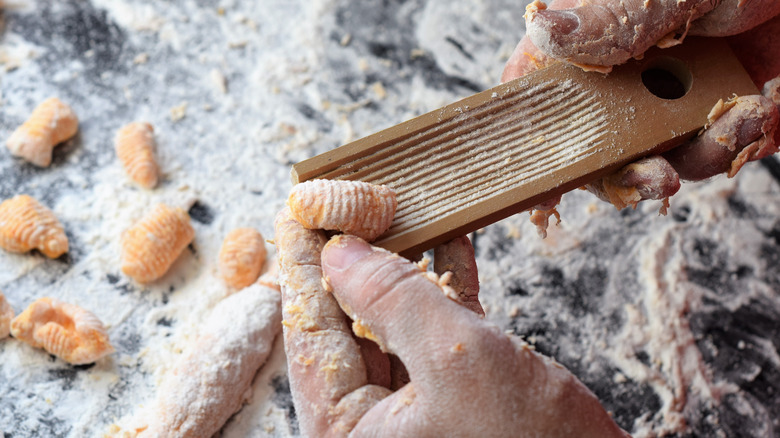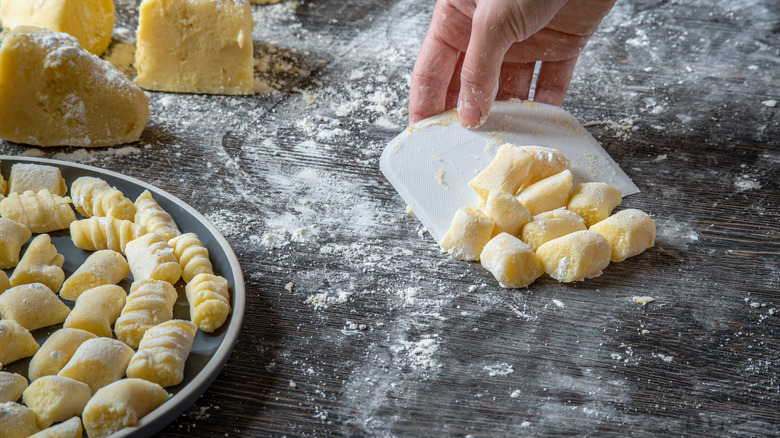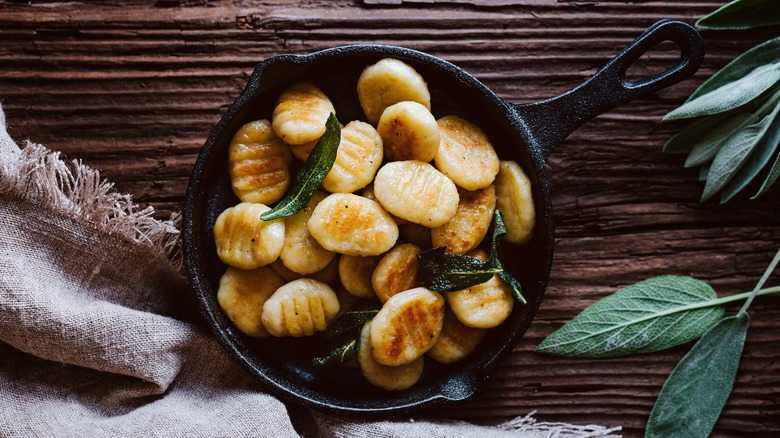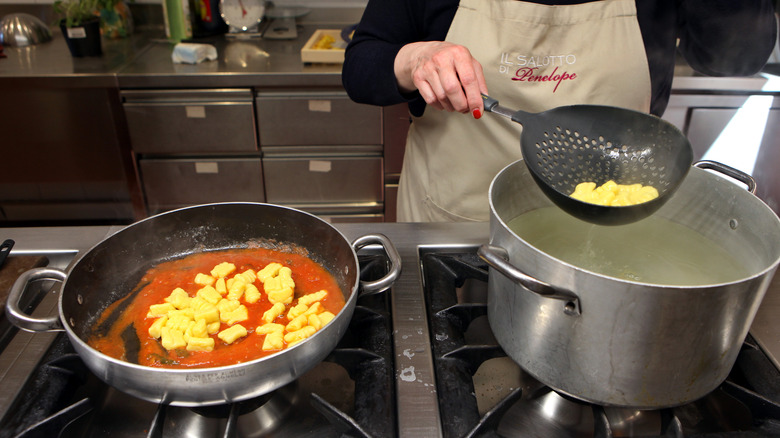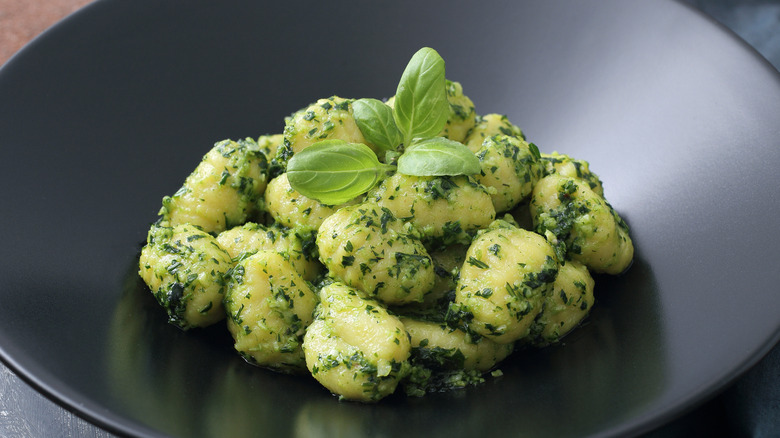10 Mistakes Everyone Makes When Making Gnocchi
While pasta is undeniably a comforting staple, a bowl of warm fluffy gnocchi is the epitome of food that feels like a hug. Gnocchi isn't technically pasta and actually falls into the category of a dumpling. Nevertheless, we tend to treat it similarly to standard pasta. We toss little pillows of gnocchi in marinara, pesto, and even just butter to soak up the flavor.
While the main ingredient in gnocchi is typically potato (as opposed to wheat flour and sometimes eggs), it can be made with a variety of different ingredients. Gnocchi, like pasta, is a dish best served fresh. It's also a relatively simple cooking project that home chefs should try at least once. It's easy to make a big batch of gnocchi and freeze it, so you'll always have some on hand.
Whether you're kneading your own homemade dough or buying the pre-made stuff, there are certain ways to approach its preparation to honor it in the best way possible. To help you avoid some pitfalls and enjoy the potato dumplings to their maximum potential, we're highlighting a few common mistakes people make with gnocchi.
1. Sticking to plain potato-based gnocchi
We may have kicked this off by talking about the wonders of standard potato-based gnocchi, but it's far from the only way to enjoy the dumplings. A common substitute is to use sweet potatoes in the gnocchi dough for a fall-flavored base that tastes delicious in a simple brown butter sauce.
Meanwhile, if the process of preparing any kind of potato for the dough sounds like too much work, ricotta cheese is a simple substitute that majorly cuts down on the preparation time. As noted by Food Network, the type of ricotta you're using will have a great impact on the consistency of the dough. If the cheese contains a lot of moisture, it risks being very wet. The best way to counter this issue is to add flour little by little as you go.
A vegetable-focused substitute for potatoes is riced cauliflower. Our 15-minute fall gnocchi recipe showcases a bag of Trader Joe's frozen cauliflower gnocchi. It's almost too easy to make and the meal is bursting with healthy nutrients and flavor.
2. Using fresh potatoes
The term "fresh ingredients" is a buzzword in cooking that makes us naively believe that fresh is always better. In the case of potatoes for gnocchi, however, fresh can actually be the downfall of the dish. Gnocchi can easily become sticky and gummy when the dough contains too much water. When potatoes are older, they tend to dry out a bit which actually results in a better consistency for gnocchi.
Additionally, as The Guardian points out, you don't want to poke the potatoes with a fork too many times while they are boiling, or else they can become waterlogged. Puncturing the potato is indeed the best way to determine whether or not it's cooked thoroughly, but it can become a major issue if your impatience causes you to do it repeatedly. Dry potatoes are so important when making gnocchi that some recipes use leftover mashed potatoes which dry out even more after being in the refrigerator.
3. Peeling the potatoes before boiling them
It might seem like second nature to peel your potatoes before boiling them as you do when making a big batch of homemade mashed potatoes. However, leaving the skin on the potatoes as they boil actually helps to prevent excess moisture from penetrating the vegetable and messing with the dough. The peel acts as a protective layer to retain the starchiness inside. Plus, once the potatoes are slightly cool, the skin will easily peel off so you can mash the flesh (via The Guardian).
While there are other options for preparing the potatoes that don't involve boiling them, this method is still pretty standard. If it's your preferred method for cooking the spuds, keeping the skin on while they're in the water bath is a small yet impactful trick that will guarantee the final result turns out exactly the way you want it to.
4. Sticking to just boiling the potatoes
Boiling may be a no-brainer, but it is far from the only way to prep a potato to be riced or mashed and formed into gnocchi dough. A popular alternative is baking the potatoes in the oven, which also helps dry them out and prevent detrimental excess moisture from impacting the texture of the dough. If you opt to bake the spuds, make sure to poke the skin a few times with a fork to prevent them from exploding in the oven. You definitely don't want to deal with that mess.
Food Network chef Giada De Laurentiis has an even easier and quicker way to prep the potatoes: microwaving them. In a video for Food Network, De Laurentiis explains that her preferred method is to microwave whole potatoes with the skin on for about 12 minutes, yielding the perfect bake. Again, make sure to poke a few holes into each potato before tossing it into the microwave to avoid a major gnocchi disaster. Otherwise, this is pretty much a foolproof procedure.
5. Overcooking the potatoes
One of the most upsetting mistakes that can occur while making homemade gnocchi is overcooking the potatoes and ending up with a dough that has a less-than-stellar consistency. It's not a totally irreversible error, but the headache can be avoided if you allow the potatoes to simply cook through without overdoing it. Chef Gianni from Gianni's North Beach explains that overcooked potatoes become waterlogged, resulting in misshapen gnocchi with a glue-like texture.
If you opt to boil your potatoes, you want to make sure to remove them from the pot the moment they are tender when tested with a knife. A potato that spends too much time in the oven or microwave won't be overly wet, but it might still fall apart and result in a mushy mess while trying to form your dough. Kitchen timers are always your friend in these situations, but be sure to check the potatoes periodically while they are cooking so they come out just right. Ultimately, preparing potatoes for gnocchi is not the time to take the "set it and forget it" method of cooking, unless you want to pay for it later in the cooking process.
6. Adding too much flour
While too much water will make your gnocchi sticky, the opposite isn't much better; too much flour will make them dense, dry, and flavorless. Part of the fun of making pasta (or pasta-adjacent dumplings like gnocchi) is to dump a bunch of flour on your counter and get your hands dirty. However, as is the case with most recipes, you can always add more as you go, but removing flour once you've incorporated it into the dough is a different problem to tackle.
The biggest tip we can offer is to take your time and remember that less is more. You'll know the gnocchi dough has enough flour when it just about comes together as a cohesive mass. If you add too much flour, you also run the risk of overworking the dough, which can also completely throw off the consistency of the final product (via Italy Magazine).
7. Letting fresh gnocchi rest too long
Gnocchi is a fickle creation, especially when it comes to obtaining the optimal texture. It's the root of most of the mistakes people make, as the consistency and balanced flavor are tricky to perfect. After forming the dough and creating tiny pillows of gnocchi, you don't want to let your masterpiece sit out too long on the counter. Sure, you have time to take pictures, but maybe wait to type up a bragging social media post until after your plate of gnocchi is totally done.
Gnocchi, even when fully formed, can dry out pretty easily. So once your dough is shaped and ready, you're either going to want to quickly pop the dumplings in boiling water or start taking the steps to freeze the raw dough. Per the Pantry & Larder blog, raw gnocchi can last up to six weeks in the freezer. On the contrary, the refrigerator is the enemy of uncooked gnocchi as it totally messes with the consistency that you spent so much time perfecting. Odds are if you're making fresh gnocchi, you will probably want to cook some immediately to enjoy the fruits of your labor and freeze the excess for later use.
8. Forgetting to crisp up the gnocchi
While most of these common gnocchi mistakes have to do with texture, there are some tricks you can employ while making the Italian dish to take your homemade version to the next level. One of the easiest steps you can add to your gnocchi-making process is to fry the dumplings in a pan with oil and/or butter or broil them in the oven for a few minutes so they brown. The inside will stay light and fluffy, but the outside will have a crispy bite that is unlike anything you've ever tasted.
It doesn't matter how you plan on enjoying your gnocchi at the end — whether it be tossed in a simple sauce or incorporated into a larger dish — crisping them up before assembling your final plate is a much-appreciated step. If you don't believe us, try out the technique and you'll understand with the first bite why this is such a key step.
9. Skipping the testing stage
Most of the mistakes people make when cooking gnocchi come down to not taking the time to patiently follow through the steps of the process. Even once your dough is made and you're ready to start forming dozens of tiny gnocchi pillows, you should first test it for consistency. Shape a couple of dumplings and cook them for a few minutes in boiling water to see how they turn out.
For example, the gnocchi could fall apart the second they hit the water if the dough is too loose. It's also possible that the gnocchi might be too dense, which is a tough problem to fix if you've overworked your entire batch of dough (via MasterClass). A good solution is to work in small batches so you can make adjustments as you go. With a bit of trial and error, you will become an expert gnocchi crafter in no time.
10. Making the same sauce for gnocchi every time
Gnocchi-specific techniques aside, one of the biggest mistakes you can make when cooking any dish is to get stuck in a rut of doing the same thing over and over again. Like pasta, gnocchi is a blank canvas to express your creativity. Gnocchi with marinara sauce or butter will always be delicious, but it's good to treat the dumplings as a special dish worthy of your favorite ingredients — especially if you take the time to make dough from scratch.
We don't just mean mixing up your choice of sauces and lightly pan-frying the gnocchis. You can make tons of recipes, from soups to creamy gnocchi bakes, that will broaden the horizons you thought these little potato dumplings could reach. For a hearty and comforting meal to enjoy as temperatures drop, try our kale and white bean gnocchi bake recipe. It only requires five ingredients, so there is no excuse not to get inspired by the simplicity and turn this potato-based dish into something worth sharing.
